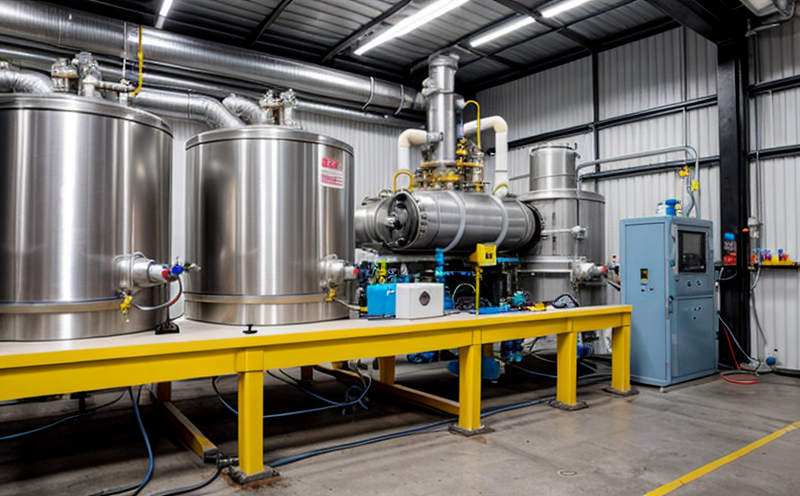ISO 12737 Neutron Irradiation Effects on Fracture Toughness
The ISO 12737 standard specifies a method to assess the effects of neutron irradiation on fracture toughness, particularly in materials commonly used in nuclear and aerospace industries. This testing is crucial for ensuring that critical components remain safe and reliable under expected operating conditions. Neutron irradiation can lead to changes in material properties such as hardness, strength, and ductility, potentially affecting a component's ability to resist crack propagation.
The test procedure involves subjecting specimens to controlled neutron flux using a reactor facility or similar source. The specimens are then evaluated for any changes in their fracture toughness through standardized testing techniques like the compact tension (CT) specimen method. This service is particularly important for materials that will be exposed to radiation fields, such as those used in nuclear power plants and space vehicles.
Specimens prepared from a wide range of materials can undergo this test, including metals, alloys, ceramics, and composite materials. The process involves precise control over irradiation parameters, including the neutron energy spectrum, flux level, and total dose. Post-irradiation testing includes detailed examination of microstructural changes using techniques such as electron microscopy (SEM) and transmission electron microscopy (TEM). These analyses help in understanding the mechanisms responsible for any observed changes in mechanical properties.
The service provided ensures compliance with international standards like ISO 12737, which provides a framework for conducting these tests reliably. By adhering to this standard, we ensure that results are consistent and comparable across different laboratories and facilities worldwide. This is vital for industries where material performance under extreme conditions can mean the difference between success and failure.
The importance of this testing cannot be overstated in sectors like nuclear energy, space exploration, and high-performance aerospace applications. The ability to predict how materials will behave after exposure to neutron radiation allows engineers to design more robust and reliable components. This not only enhances safety but also optimizes the performance and longevity of critical infrastructure.
For instance, in nuclear reactors, where neutron flux is a natural byproduct of fission reactions, understanding the effects on structural materials can help prevent accidents caused by unexpected material degradation. Similarly, for spacecraft materials, which must withstand the harsh environment of space, knowing how they will react to radiation exposure is essential for mission success.
The process involves several key steps:
- Selection and preparation of test specimens
- Irradiation in a controlled neutron flux environment
- Post-irradiation evaluation using advanced microscopy techniques
- Detailed analysis to correlate irradiation dose with changes in fracture toughness
This service is designed for quality managers, compliance officers, and R&D engineers who need accurate data on how materials perform under neutron radiation. By providing precise and reliable results, we help clients make informed decisions that can significantly impact the safety and efficiency of their products.
Why It Matters
The effects of neutron irradiation on fracture toughness are critical for ensuring the reliability and longevity of materials in high-stress environments. In nuclear reactors, where neutrons are a natural byproduct of fission reactions, understanding how these particles affect structural integrity is essential. The same applies to space vehicles, which must withstand intense radiation from cosmic rays during long-duration missions.
Faulty components due to neutron-induced changes can lead to catastrophic failures with severe consequences. For example, in nuclear power plants, a crack in a critical component could cause a containment failure leading to radioactive leaks. In aerospace applications, similar issues could result in spacecraft malfunctions or even loss of mission. Thus, the ability to predict and mitigate such risks is paramount.
The ISO 12737 standard provides a robust framework for conducting these tests, ensuring that results are consistent and reliable across different facilities. This consistency is crucial for industries where material performance under extreme conditions can mean the difference between success and failure. By providing accurate data on how materials behave after exposure to neutron radiation, this service helps clients make informed decisions that enhance safety and optimize product performance.
For quality managers and compliance officers, ensuring adherence to international standards like ISO 12737 is essential for maintaining regulatory compliance. For R&D engineers, the ability to test materials under controlled conditions provides valuable insights into their behavior in real-world scenarios. This knowledge can be used to improve design processes and enhance the performance of critical components.
Benefits
- Precise evaluation of how neutron irradiation affects fracture toughness
- Compliance with international standards like ISO 12737
- Accurate data for making informed design and manufacturing decisions
- Enhanced safety in critical applications such as nuclear reactors and space vehicles
- Prediction of material performance under extreme conditions
- Consistent results across different facilities ensuring reliability
- Supports regulatory compliance and quality assurance processes
Environmental and Sustainability Contributions
The ISO 12737 testing service plays a crucial role in promoting environmental sustainability by ensuring the safety and longevity of materials used in critical applications. By providing accurate data on how neutron irradiation affects fracture toughness, we help minimize the risk of failures that could lead to catastrophic incidents. This reduces the need for premature replacements or emergency repairs, thereby extending the operational life of nuclear reactors and space vehicles.
Longer operational lifetimes translate into reduced waste generation and lower resource consumption. For instance, in nuclear power plants, where neutron irradiation is a natural byproduct of fission reactions, understanding how materials behave under these conditions allows for more efficient design and operation. This can result in less frequent refueling and maintenance, reducing the overall environmental impact.
In aerospace applications, similar insights help optimize mission designs to ensure long-term reliability with minimal environmental footprint. By providing accurate data on material performance, this service supports sustainable practices that are essential for a greener future. Ensuring the safety and longevity of critical infrastructure not only enhances operational efficiency but also contributes positively to global sustainability goals.





